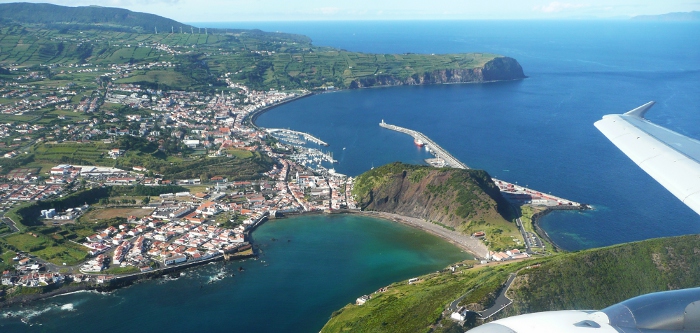Lying in the Atlantic Ocean about 1500km from Lisbon, Faial is a small volcanic island with 173km2 and less than 1 million years old. It is almost pentagonal in shape, measuring 21km in length and 14km wide, with an encircling 54km road that runs along the coast. The island is mountainous and is dominated by its central crater (Caldeira) and nearby highest point Cabeço Gordo of 1043m. From there a sequence of secondary volcanic cones spread westwards to Capelinhos, where an eruption in 1957/8 added 1,5km2 to the island.
With an outstanding location in the heart of the Triangle formed by Faial, Pico and São Jorge islands – just 8,3km away from Pico and 26km from S. Jorge - Faial is the perfect retreat for nature lovers, whale watchers and scuba divers. Verdant and tranquil, with beautiful landscapes and an incredible blue ocean with prolific marine life, the island remains untouched by mass tourism. Faial is known as the Blue Island because of its abundant blue hydrangeas that bloom in summer. Horta is the only town and one of the most beautiful of the archipelago, with an outstanding view to Pico Mountain, Portugal’s highest mountain (2,351m). The cosmopolitan port of Horta is an important stopover for transatlantic yachts, with more than 1,000 visiting boats a year, especially between April and August. Colourful paintings and messages adorn the walls and pavements of the marina, an unique testimony by all sailors that cross the Atlantic.
Faial’s population is around 15,000 people with half this number living in Horta.
Some History…
15th Century – The original name of Faial was Insule de Ventura and it was possibly discovered by navigator Diogo de Silves, while in the service of King of Portugal, in 1427. In 1432 a small group of Portuguese settlers came from Terceira Island to settle in the northern pastures of Cedros. Duchess Isabel of Burgundy, daughter of King João I and married to Philip III, Duke of Burgundy and Count of Flanders, authorized the settlement of lands on the island. Flemish settlers under contract from the crown, and led by the nobleman Josse Van Huertere, came to Faial and together with the Portuguese settlers, Horta was formed. Some time later the island’s name changed to Fayal (now Faial), due to the abundant forests of Myrica faya. With the island's improving economy more Portuguese settled there and rapidly the Flemish influence diminished.
16th Century - This was a period of instability, mainly because of the annexation of Portugal by Spain (1580-1640).
17th Century – A time of great prosperity to Faial as a result of the safe nature of the port and its strategic position. International trade expanded and Horta became the main port for the export of wine and brandy produced by the neighbouring islands of Pico, S. Jorge and Graciosa.
18-19th Century – Horta became a busy sea port, then the only really safe anchorage in the Azores. Early Yankee whaling fleets came to Horta for supplies, rest and recruit crews, anchoring in Porto Pim. In 1876 work started on the docks and sea wall to better protect the port, offering a safer anchorage. As time progressed, Faial's importance expanded through its dock, as a waypoint to trans-Atlantic traffic, with whaling, wine and orange exports predominating.
The presence of American whaling ships started to decline towards the end of the 1800s and a local whaling industry from land-based stations started to emerge in the Azores, first in Pico and soon afterwards in Faial and other islands.
20th-21st Century – The first transatlantic crossing by seaplane landed in Horta in 1919. Soon after 1933 Horta became the regular stopover for the Pan-Am clipper flights en route from America to Europe, to be followed by Lufthansa, Air France and Imperial Airways, now British Airways.
Horta’s mid-Atlantic position was ideal and intercontinental submarine cable stations were installed and Horta became one of the most important cable centres in the world. During the two world wars Horta also played an important role as a naval base.
In 1957, a submarine eruption started about 1km far from the Capelinhos Islets, in the west coast of Faial. Eruptions continued through 1958 and more than 1,5km2 of land had been added to Faial Island. The eruption changed the lives of many islanders when hundreds emigrated to the USA and Canada, leaving Faial with half of its original population (about 30,000 people).
Whale hunting as a viable industry began to decline from the 1960’s. Meanwhile, Portugal had signed the Treaty of Berne in 1981, whale hunting was prohibited and all cetaceans in Azorean and Portuguese waters became protected by both international and national laws. Azores is an autonomous region of the Portuguese Republic since 1976, and Faial is today one of the main administrative centres of the archipelago and the Seat of the Regional Parliament.
With Horta as the capital of international yachting in this part of the world and an economy based on trade, cattle-rearing, dairy products and fishing, Faial is nowadays an island that is still developing that has found in tourism a means of pursuing its cosmopolitan vocation.

